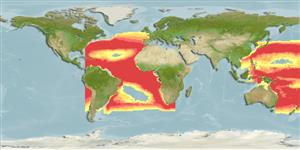Actinopterygii (ray-finned fishes) >
Myctophiformes (Lanternfishes) >
Myctophidae (Lanternfishes) > Lampanyctinae
Etymology: Diaphus: Greek, dis, dia = through + Greek, physa, phyo = to beget, to have as offspring (Ref. 45335).
Environment / Climate / Range
Ecology
Marine; bathypelagic; oceanodromous (Ref. 51243); depth range 40 - 850 m (Ref. 4479), usually 400 - 500 m (Ref. 4479). Deep-water, preferred ?; 52°N - 48°S, 78°W - 180°W
Eastern Atlantic: Morocco to Mauritania. Western Atlantic: USA to 10°N including Caribbean, Lesser Antilles (Ref. 4775). Northwest Atlantic: Canada (Ref. 5951). Western Central Pacific: southeast Asian seas between 8°N and 7°S, New Caledonia and New Zealand. Also known from the Eastern Central Pacific (Ref. 9325).
Length at first maturity / Size / Weight / Age
Maturity: Lm ?, range 6 - ? cm
Max length : 8.0 cm SL male/unsexed; (Ref. 4479)
High-oceanic, found between 325-850 m during the day (most abundant at 400-500 m) and between 40-225 m at night (most abundant 100 m) (Ref. 4479). Mesopelagic (Ref. 5951, 75154).
Life cycle and mating behavior
Maturity | Reproduction | Spawning | Eggs | Fecundity | Larvae
Hulley, P.A., 1990. Myctophidae. p. 398-467. In J.C. Quero, J.C. Hureau, C. Karrer, A. Post and L. Saldanha (eds.) Check-list of the fishes of the eastern tropical Atlantic (CLOFETA). JNICT, Lisbon; SEI; Paris; and UNESCO, Paris. Vol. 1. (Ref. 4479)
IUCN Red List Status (Ref. 115185)
CITES (Ref. 94142)
Not Evaluated
Threat to humans
Harmless
Human uses
More information
ReferencesAquacultureAquaculture profileStrainsGeneticsAllele frequenciesHeritabilityDiseasesProcessingMass conversion
Tools
Special reports
Download XML
Internet sources
